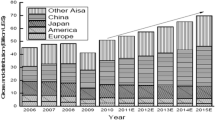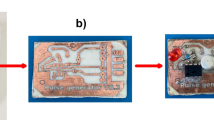Abstract
tAs the number of electronic products in use increases, so does the need to dispose of defective and obsolete equipment, including printed circuit boards. The utilization of mechanical processing in recycling this type of waste enables recovery of the metals and allows components to be separated for proper waste disposal. Mechanical processing allows the recovery of 80% of the metals in printed circuit boards, especially copper, which represents approximately 75% of the metallic fraction.
Similar content being viewed by others
References
J.E. Hoffmann, “Recovery of Precious Metals from Electronic Scrap,”JOM, 44 (6) (1992), pp. 43–48.
A. Bernardes et al., “Recycling of Printed Circuit Boards by Melting with Oxidising/Reducing Top Blowing Process” (Paper presented at the TMS Annual Meeting, Orlando, Florida, 9–13 February 1997).
N. Felix and C. Riet, “Recycling of Electronic Scrap,”Proc. Precious Metals Conf. (1994), pp. 159–169.
K.L. Sandvik et al., ”Development of a Mineral Processing Modelling Program as a Tool for Optimal Decisions in Waste Treatment,”REWAS 1999, vol. 1 (Warrendale, PA: TMS, 1999), pp. 55–64.
E. Larrauri, R. Miguel, and M.J. Suarez, “Recovery, Recycling and Reuse of Packing Materials from Post Consumer Wastes,” in Ref. 4, pp. 75–84.
M.J. Noakes, “Using Mineral Processing Technologies for the Treatment of Hazardous Substances,” in Ref. 4, pp. 27–36.
J.A.S. Tenório, D.C. Oliveira, and A.P. Chaves, “Carbon-Zinc Batteries Treatment by Ore Processing Methods,”REWAS 1999, vol. 2 (Warrendale, PA: TMS, 1999), pp. 1153–1160.
S. Zhang and E. Forssberg, “Mechanical Separation-Oriented Characterization of Electronic Scrap,”Resources, Conservation and Recycling, 21 (1997), pp. 247–269.
J.J. Peirce, R.F. Weiner, and P.A. Vesilind,Environmental Pollution and Control, 4th ed. (Stoneham, MA: Butterworth-Heinemann, 1998).
I. Saito, “Recovery of Valuable Metals from Printed Wiring Board Wastes,”Trans. Mater. Res. Soc. Jpn., 18A (1994), pp. 207–210.
J.A.S. Tenório, R.P. Menetti, and A.P. Chaves, “Production of Non-Ferrous Metallic Concentrates from Electronic Scrap,”EPD Congress, 1997, ed. B. Mishra (Warrendale, PA: TMS, 1997), pp. 505–509.
P.C. Hayes,Process Principles in Minerals and Materials Production (Hayes Publishing Co., 1993).
G. Ferrara et al., “The Influence of Particle Shape on the Dynamic Dense Medium Separation of Plastics,”Int. J. Mineral Processing, 59 (2000), pp. 225–235.
Author information
Authors and Affiliations
Rights and permissions
About this article
Cite this article
Veit, H.M., de Pereira, C.C. & Bernardes, A.M. Using mechanical processing in recycling printed wiring boards. JOM 54, 45–47 (2002). https://doi.org/10.1007/BF02701850
Issue Date:
DOI: https://doi.org/10.1007/BF02701850




